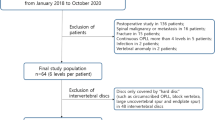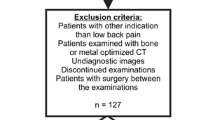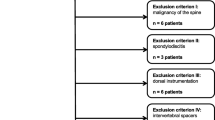Abstract
Objectives
To compare the diagnostic performance and image quality of dual-energy computed tomography (DECT) with electron density (ED) image reconstruction with those of DECT with standard CT (SC) and virtual non-calcium (VNCa) image reconstructions, for diagnosing lumbar disc herniation (L-HIVD).
Methods
A total of 59 patients (354 intervertebral discs from T12/L1 to L5/S1; mean age, 60 years; 30 women and 29 men) who underwent DECT with spectral reconstruction and 3-T MRI within 2 weeks were enrolled between March 2021 and February 2022. Four radiologists independently assessed three image sets of randomized ED, SC, and VNCa images to detect L-HIVD at 8-week intervals. The coefficient of variance (CV) and the Weber contrast of the ROIs in the normal and diseased disc to cerebrospinal fluid space (NCR-normal/-diseased, respectively) were calculated to compare the image qualities of the noiseless ED and other series.
Results
Overall, 129 L-HIVDs were noted on MRI. In the detection of L-HIVD, ED showed a higher AUC and sensitivity than SC and VNCa; 0.871 vs 0.807 vs 833 (p = 0.002) and 81% vs 70% vs 74% (p = 0.006 for SC), respectively. CV was much lower in all measurements of ED than those for SC and VNCa (p < 0.001). Furthermore, NCR-normal and NCR-diseased were the highest in ED (ED vs SC in NCR-normal and NCR-diseased, p = 0.001 and p = 0.004, respectively; ED vs VNCa in NCR-diseased, p = 0.044).
Conclusion
Compared to SC and VNCa images, DECT with ED reconstruction can enhance the AUC and sensitivity of L-HIVD detection with a lower CV and higher NCR.
Clinical relevance statement
To our knowledge, this is the first study to quantify the image quality of noiseless ED images. ED imaging may be helpful for detecting L-HIVD in patients who cannot undergo MRI.
Key Points
-
ED images have diagnostic potential, but relevant quantitative analyses of image quality are limited.
-
ED images detect disc herniation, with a better coefficient of variance and normalized contrast ratio values.
-
ED images could detect L-HIVD when MRI is not an option.





Similar content being viewed by others
Abbreviations
- AUC:
-
Area under the ROC curve
- CV:
-
Coefficient of variance
- DECT:
-
Dual-energy CT
- ED:
-
Electron density
- HU:
-
Hounsfield units
- NCR:
-
Normalized contrast ratio
- NPV:
-
Negative predictive value
- PPV:
-
Positive predictive value
- SC:
-
Standard CT
- VNCa:
-
Virtual non-calcium
References
Martin BI, Deyo RA, Mirza SK et al (2008) Expenditures and health status among adults with back and neck problems. JAMA 299:656–664
Ghadimi MSA. Magnetic Resonance Imaging Contraindications: StatPearls; 2023
Expert Panel on Pediatric I, Kadom N, Palasis S et al (2019) ACR appropriateness criteria® suspected spine trauma-child. J Am Coll Radiol 16:S286–S299
Huang Z, Zhao P, Zhang C, Wu J, Liu R (2022) Value of imaging examinations in diagnosing lumbar disc herniation: a systematic review and meta-analysis. Front Surg 9:1020766
Lianglong W, Liu L (2020) Analysis of the application value of MRI and CT diagnosis of lumbar disc herniation. Proc Anticancer Res 4:19–22
Booz C, Noske J, Martin SS et al (2019) Virtual noncalcium dual-energy CT: detection of lumbar disk herniation in comparison with standard gray-scale CT. Radiology 290:446–455
Booz C, Yel I, Martin SS et al (2021) Incremental diagnostic value of virtual noncalcium dual-energy computed tomography for the depiction of cervical disk herniation compared with standard gray-scale computed tomography. Invest Radiol 56:207–214
Nagano H, Takumi K, Nakajo M et al (2022) Dual-energy CT derived electron density for diagnosing metastatic mediastinal lymph nodes in non-small cell lung cancer: comparison with conventional CT and FDG PET/CT findings. AJR Am J Roentgenol 218:66–74
Daoud B, Cazejust J, Tavolaro S et al (2021) Could spectral CT have a potential benefit in coronavirus disease (COVID-19)? AJR Am J Roentgenol 216:349–354
Tatsugami F, Higaki T, Kiguchi M et al (2014) Measurement of electron density and effective atomic number by dual-energy scan using a 320-detector computed tomography scanner withr data-based analysis: a phantom study. J Comput Assist Tomogr 38:824–827
Sudhyadhom A (2020) On the molecular relationship between Hounsfield Unit (HU), mass density, and electron density in computed tomography (CT). PLos One 15:e0244861
Liu S, Pan H, Wu S et al (2023) Diagnostic value of dual-energy CT virtual non-calcium and Rho/Z images for bone marrow infiltration in primary malignant bone tumors. Acad Radiol 30:1659–1666
Luo YH, Mei XL, Liu QR et al (2023) Diagnosing cervical lymph node metastasis in oral squamous cell carcinoma based on third-generation dual-source, dual-energy computed tomography. Eur Radiol 33:162–171
Nelles C, Lennartz S (2023) Spinal hematoma visualized with dual-energy CT-derived electron density overlay maps. Radiology 307:e222680
Sedaghat S, Langguth P, Larsen N et al (2023) Diagnostic accuracy of dual-layer spectral CT using electron density images to detect post-traumatic prevertebral hematoma of the cervical spine. Rofo 193:1445–1450
Shim E, Kim BH, Kang WY et al (2022) Diagnostic performance of electron-density dual-energy CT in detection of cervical disc herniation in comparison with standard gray-scale CT and virtual non-calcium images. Eur Radiol 32:2209–2220
Judith E, Adams ZM, Damilakis J, Amaka C (2012) Offiah. Radiology. In: Francis H Glorieux, John M Pettifor, Harald Juppner (eds) Pediatric bone biology and diseases, 2nd edn. Elsevier Inc, California, pp 278–279
Brandelik SC, Skornitzke S, Mokry T et al (2021) Quantitative and qualitative assessment of plasma cell dyscrasias in dual-layer spectral CT. Eur Radiol 31:7664–7673
Pfirrmann CW, Dora C, Schmid MR et al (2004) MR image-based grading of lumbar nerve root compromise due to disk herniation: reliability study with surgical correlation. Radiology 230:583–588
Fardon DF, Williams AL, Dohring EJ et al (2014) Lumbar disc nomenclature: version 2.0: recommendations of the combined task forces of the North American Spine Society, the American Society of Spine Radiology and the American Society of Neuroradiology. Spine J 14:2525–2545
Hua CH, Shapira N, Merchant TE et al (2018) Accuracy of electron density, effective atomic number, and iodine concentration determination with a dual-layer dual-energy computed tomography system. Med Phys 45:2486–2497
Carrasco JL, Jover L (2003) Estimating the generalized concordance correlation coefficient through variance components. Biometrics 59:849–858
Lim S, Kim SH, Kim Y et al (2018) Coefficient of variance as quality criterion for evaluation of advanced hepatic fibrosis using 2D shear-wave elastography. J Ultrasound Med 37:355–362
Covert EC, Fitzpatrick K, Mikell J et al (2022) Intra- and inter-operator variability in MRI-based manual segmentation of HCC lesions and its impact on dosimetry. EJNMMI Phys 9:90
Anvari A, Halpern EF, Samir AE (2018) Essentials of statistical methods for assessing reliability and agreement in quantitative imaging. Acad Radiol 25:391–396
Su HN, Yu L, Jung C (2022) Joint contrast enhancement and noise reduction of low light images via JND transform. IEEE Trans Multimed 24:17–32
Pelli DG, Bex P (2013) Measuring contrast sensitivity. Vis Res 90:10–14
Yushkevich PA, Piven J, Hazlett HC et al (2006) User-guided 3D active contour segmentation of anatomical structures: significantly improved efficiency and reliability. Neuroimage 31:1116–1128
Loizou CP, Pantziaris M, Seimenis I et al (2009) Brain MR image normalization in texture analysis of multiple sclerosis. 2009 9th International conference on information technology and applications in biomedicine. J Biomed Graph Comput https://doi.org/10.1109/ITAB.2009.5394331
Giannini V, Panic J, Regge D et al (2023) Could normalization improve robustness of abdominal MRI radiomic features? Biomed Phys Eng Express 9:055002
Dorfman DD, Berbaum KS, Metz CE (1992) Receiver operating characteristic rating analysis. Generalization to the population of readers and patients with the jackknife method. Invest Radiol 27(9):723–731
Obuchowski NA, Rockette HE (1995) Hypothesis testing of diagnostic accuracy for multiple readers and multiple tests: an ANOVA approach with dependent observations. Commun Stat Simul Comput 24(2):285–308
Smith BJ, Hillis SL, Pesce LL (2023) MCMCaov: multi-reader multi-case analysis of variance. R package version 0.3.0. https://github.com/brian-j-smith/MRMCaov>
Landis JR, Koch GG (1997) The measurement of observer agreement for categorical data. Biometrics 33:159–174
Chakrabarti R, Gupta V, Vyas S et al (2022) Correlation of dual energy computed tomography electron density measurements with cerebral glioma grade. Neuroradiol J 35:352–362
Hua C, Shapira N, Merchant T et al (2018) Accuracy of electron density, effective atomic number, and iodine concentration determination with dual-layer CT. Med Phys 45:2486–2497
Johnson TR, Krauss B, Sedlmair M et al (2007) Material differentiation by dual energy CT: initial experience. Eur Radiol 17:1510–1517
Pohlan J, Stelbrink C, Pumberger M et al (2021) Age-dependent microstructural changes of the intervertebral disc: a validation of proteoglycan-sensitive spectral CT. Eur Radiol 31(12):9390–9398
Abdellatif W, Nugent JP, Alballa F et al (2023) Dual energy computed tomography collagen material decomposition for detection of lumbar spine disc extrusion and sequestration: a comparative study with greyscale computed tomography. Can Assoc Radio J 74:110–118
Suresh KP (2011) An overview of randomization techniques: an unbiased assessment of outcome in clinical research. J Hum Reprod Sci 4:8–11
Acknowledgements
The authors thank Youngmi Chun and Seonyoung Kang of Phillips Healthcare for their insightful discussions and assistance.
Funding
This study was supported by a grant from Korea University.
Author information
Authors and Affiliations
Corresponding author
Ethics declarations
Guarantor
The scientific guarantor of this publication is Euddeum Shim.
Conflict of interest
The authors of this manuscript declare no relationships with any companies, whose products or services may be related to the subject matter of the article.
Statistics and biometry
Hangseok Choi, PhD has significant statistical expertize.
Informed consent
Written informed consent was waived by the Institutional Review Board.
Ethical approval
Institutional Review Board approval was obtained.
Study subjects or cohorts overlap
The study has not been previously reported.
Methodology
-
Retrospective
-
Diagnostic or prognostic study
-
Performed at one institution
Additional information
Publisher’s Note Springer Nature remains neutral with regard to jurisdictional claims in published maps and institutional affiliations.
Supplementary Information
Rights and permissions
Springer Nature or its licensor (e.g. a society or other partner) holds exclusive rights to this article under a publishing agreement with the author(s) or other rightsholder(s); author self-archiving of the accepted manuscript version of this article is solely governed by the terms of such publishing agreement and applicable law.
About this article
Cite this article
Jeong, J., Ham, S., Shim, E. et al. Electron density dual-energy CT can improve the detection of lumbar disc herniation with higher image quality than standard and virtual non-calcium images. Eur Radiol (2024). https://doi.org/10.1007/s00330-024-10782-9
Received:
Revised:
Accepted:
Published:
DOI: https://doi.org/10.1007/s00330-024-10782-9




